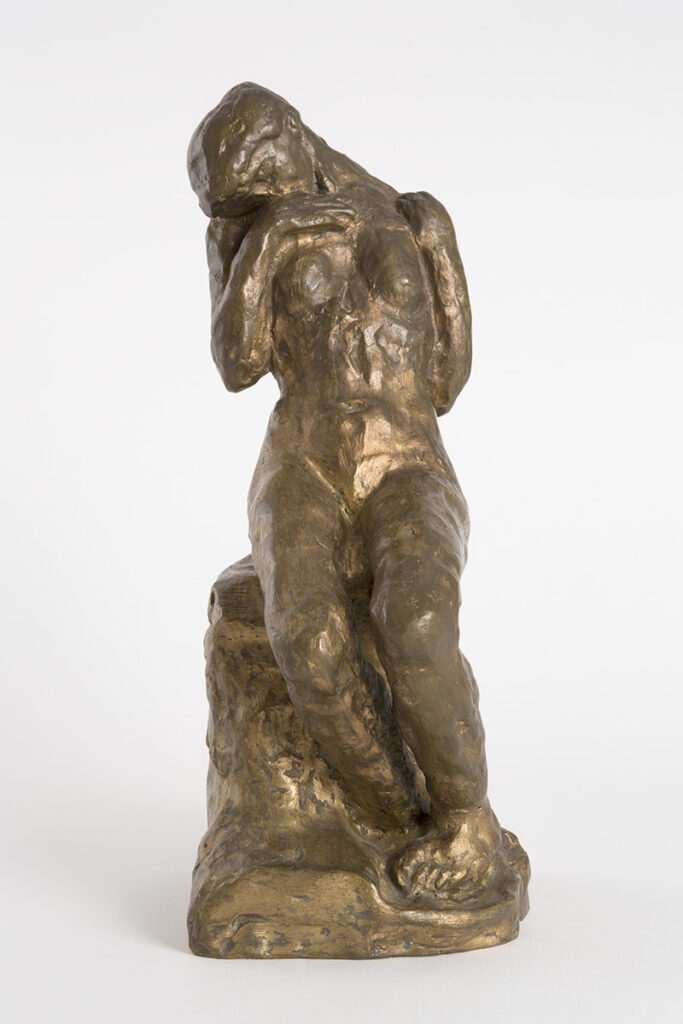Josef Kostka’s work is diverse. Since the very beginning of his career he had been admired poetry and wanted to work on sculptures with a rich internal life, full of associations, spiritual bonds with the world, its time, its mementos and pains. Early sculptures by Kostka were inspired by the Ancient arts, by the works of Michelangelo Buonarotti, the high Baroque art. The answers for his pursuits he found in the works of August Rodin or E.A. Bourdello. Kostka’s early works were created emotively with a remarkable signature.
After 1940 his works were imbued with the sensually charged archaic accents of Bourdello. The material of soft and flexible clay that served him to model poetic, lyrical figures with metaphorical accents suited his inborn creative nature. This vitalist, harmonizing perspective gradually disappeared from his sculptures. His works started to be dominated by disharmonic, tragic feelings that resulted from the crushing war atmosphere.
His sculpture “Mourning Woman” is one of his lyrical renderings that expressively reflected deep authorial relationship to his artwork and resulted also in a form deformation. The artist, in addition to a sensitive modelling of the figure, studied also its anatomy. He purposely added or reduced the matter to produce certain dynamism of space. He developed the surface of the matter and calculated with the changeability of light enabling the revelation of other layers of meaning whether they are lyrical or dramatic.
Seemingly static “Mourning Woman” statue of a seated, naked female figure cuddled in melancholic pain, full of anxiety, is eventually an expression of action and at the same time passivity. Kostka thoughtfully used the elements of a diagonal composition and disbalanced the centre of gravity. When composing the body the details of the face receded. He achieved dramatic effects of strong, nostalgic emotions with reclined head and hand gestures.
“To penetrate into the soul of a poet,
in his work we find the words
that occur most frequently.
The words disclose what he is obsessed with.“
Charles Baudelaire
Jozef Kostka (1912 – 1996)
His teacher was his uncle Ferdiš Kostka, a folk ceramic maker from Stupava. He developed his artistic talent he inherited after his ancestors at the Secondary School of Applied Arts in Brno and Prague lead by the professor Karel Dvořák in 1932 -1937. He finished a year of studies at École des Beaux-Arts in Paris in the academic year 1938-1939. The same year he participated in the exhibition of Slovak art in New York. Since 1939 he had been an assistant professor at the Department of Drawing and Painting at the Slovak Technical University in Bratislava. He taught at the Slovak Technical University as an associate professor from 1943. He was the full professor at the Pedagogical Faculty at the Comenius University in Bratislava from 1947 to 1949. Two years later, in 1949, he participated in the opening of the Slovak National Gallery and the Academy of Fine Arts in Bratislava. He worked there as a full professor and the head of the Department of Figurative Sculpture. From 1955 to 1959 he was the rector. In 1958 to 1969 his exhibitions were held in Slovakia and abroad. He went for study trips to England, France and Italy in the years 1966 -1968. In 1967 he was awarded the honorary title national artist. For a year he acted as a president of the Union of Slovak Artists (1969 -1970). He was a member of several artistic unions not only in Slovakia but also in the Czech Republic. He had to retire and leave the Academy of Fine Arts for political reasons in 1973. During his creative life he had received a lot of awards and prizes. He produced monumental but also small size works.
He died in Bratislava on Sept 30, 1996. Two years later his wife Anna Kostková founded the Jozef Kostka Foundation. In 2000 the Jozef Kostka Gallery was open, his wife Anna built it above the artist’s house in Na Záhradach 17 in Bratislava.
— Marta Hučková, June 2013
Literature
Peterajová, Ľ.: Súčasné české a slovenské umenie. In: Slovenské umenie. Jozef Kostka. Tatran Bratislava, 1983, pp.358-359
Dubnický, J.: Súčasné slovenské umenie. In: Kostka. Nakl. V.H. Kurthu, Bratislava, 1944
Macharáčková, M.: Jozef Kostka – klasik slovenskej sochárskej moderny. Nitrianska galéria.2013
Inventory No.: P 288
Artist: Jozef Kostka
Title: Mourning Woman
Year of origin: 1943
Technique: modelling, cast
Material: bronze
Dimensions: 41 × 15,5 × 22 cm
Marked: unmarked
